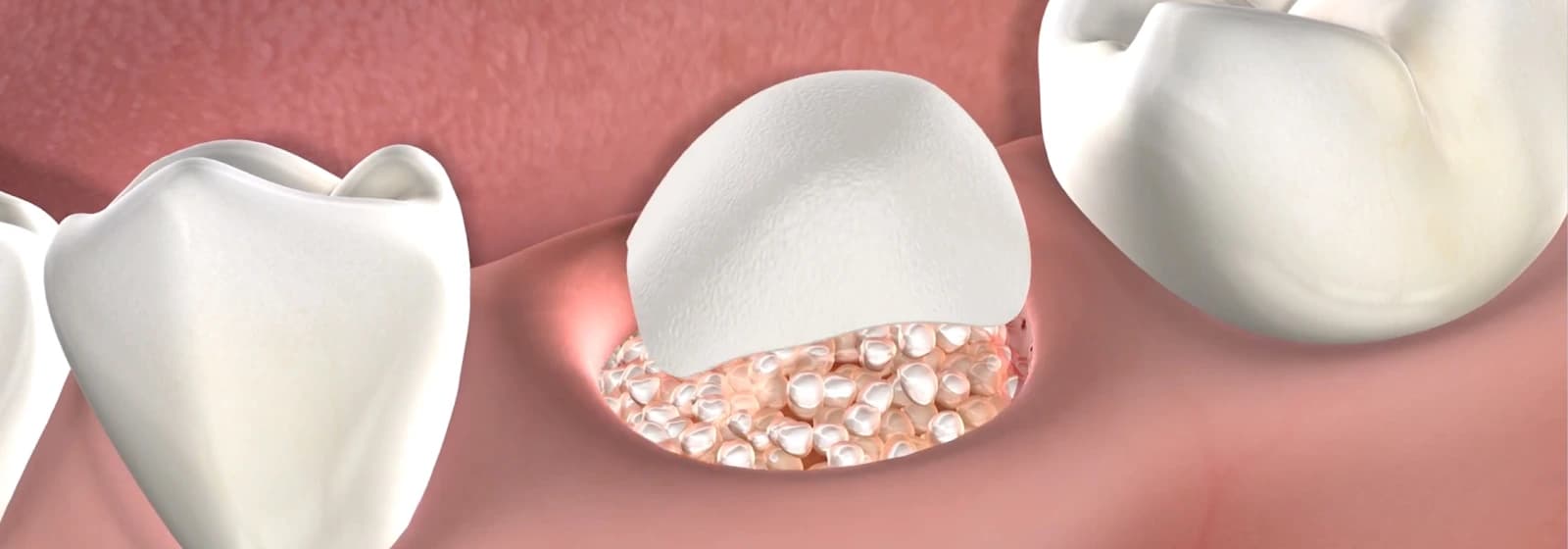Bone grafting is a remarkable treatment that rebuilds the face and jaw bones where bone loss has occurred. We often perform bone grafting prior to placing a dental implant to provide the implant with a healthy and strong foundation. Contact Lubbock Dental Specialists in Lubbock or Amarillo, TX, to schedule an appointment with one of our board-certified oral and maxillofacial surgeons, Dr. Graves and Dr. Wilkinson. We will examine your oral health, create a personalized treatment plan, and determine if bone grafting is necessary to restore your oral health and function.
How Do Bone Grafts Work?
A dental bone graft is a surgical procedure that rebuilds facial bone by adding volume and density to areas where bone loss has occurred. The grafting material may be taken from your own body (autogenous graft), a human tissue bank (allograft), an animal tissue bank (xenograft), or made from synthetic materials (alloplast). Bone grafts act as scaffolds for new bone tissue to grow around. After a graft is placed, your body will create new bone to heal around it, resulting in healthier and stronger bone.
Bone Grafting and Oral Surgery
The ability to rebuild bone is an incredible advancement in modern dentistry and helps more patients qualify for implant-based restorations. Whether you have experienced bone loss due to a missing tooth, taking certain medications, or experiencing facial trauma, bone grafting can restore shape and function to the face and jaw. Bone grafting is often a part of dental implant treatment because a sturdy foundation is necessary for a healthy and successful implant. Bone grafting can also be used in combination with other oral surgery treatments, such as:
Types of Bone Grafting Treatments
There are a variety of bone grafting treatments available. During your first visit to Lubbock Dental Specialists, we will take 3D scans of your mouth and face to evaluate your oral health. The right option for you will depend on your condition and the severity and location of the bone loss. Before your surgical procedure, Dr. Graves and Dr. Wilkinson will also help you choose the right type of anesthesia or sedation to ensure your comfort.
Socket Preservation
Following a tooth extraction, we can insert bone grafting material inside the empty tooth socket to preserve the socket’s size and shape. Socket preservation makes future implant placement easier and helps prevent bone loss that can occur as a result of missing teeth.
Sinus Lift/Sinus Augmentation
The sinuses are hollow cavities behind the cheeks, and the wall that separates the sinus cavity from the upper teeth can be thin, making it difficult to place a dental implant. During a sinus lift procedure, we will lift the sinus wall and insert grafting material beneath it. Once healed, there will be enough bone structure present to successfully support the dental implants.
Ridge Expansion
The alveolar ridge holds the teeth in place, and when teeth are missing, this bone begins to deteriorate. If the ridge is too narrow or short, it will not be able to support a dental implant. During a ridge expansion procedure, we surgically split the jawbone and insert bone grafts into the open spaces. The result is a wider, more structurally sound jaw that can support dental implants.
Nerve Repositioning
The inferior alveolar nerve lies beneath your lower molars. This nerve provides sensation to the chin and lower jaw. Sometimes, this nerve does not provide enough room to place a dental implant in the lower jaw. During a nerve repositioning procedure, we will isolate the nerve, gently pull it to the side, insert the dental implant, and place the nerve back over the implant. The surgical access is then filled with graft material.
Soft Tissue Graft
Periodontal disease, genetics, aggressive brushing, or other factors can cause the gums to recede. A soft tissue graft can restore shape to the gums where recession has occurred and can be used to cover exposed roots. A healthy and uniform gum line will improve the aesthetics of your smile, protect teeth roots, and reduce sensitivity.
Platelet-Rich Growth Factors (PRGF)
There are naturally occurring healing factors within your body called platelet-rich growth factors, or PRGF. Before your surgery, we can harvest these growth factors from a small blood sample and apply them directly to the surgical site. This process takes advantage of your body’s natural healing abilities to expedite the recovery process.
BMAC
We offer Harvest® BMAC treatment to expedite the bone regeneration process. Bone marrow aspirate concentrate (BMAC) naturally exists within your bone marrow and contains growth factors and anti-inflammatory proteins. Similar to the process of applying PRGF, we can harvest a small sample of BMAC from your own body and apply it directly to the bone grafting area.
Bone Grafting at Lubbock Dental Specialists
If you require treatment for bone loss or lack sufficient jawbone for dental implants, we encourage you to contact Lubbock Dental Specialists. Our team offers many bone grafting treatments. Schedule an appointment by filling out an online registration form.
Contact us by giving us a call at (806) 412-0000 or (806) 353-1055 in Lubbock, Amarillo, or Plainview, TX, or by sending us an email at [email protected], so that we can restore your oral health and provide you with a healthy foundation for your dental implants.

